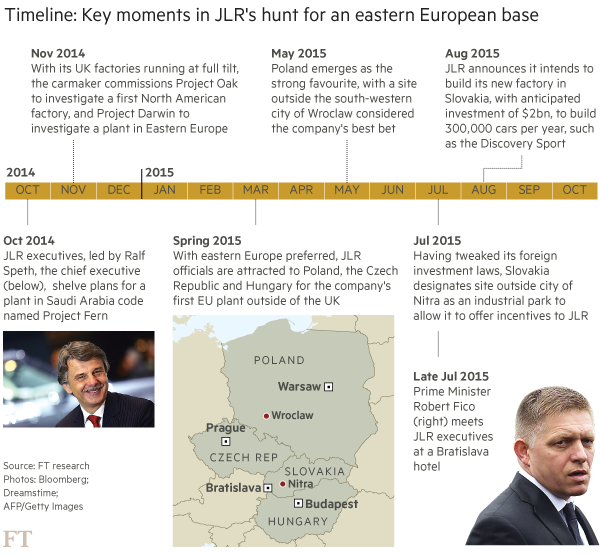Poland has to settle for ‘second best’ after JLR factory loss

Roula Khalaf, Editor of the FT, selects her favourite stories in this weekly newsletter.
“We have lost the fight for the biggest automotive investment of this decade,” screamed newspaper headlines when it emerged Jaguar Land Rover would build its factory in Slovakia and not in Poland.
But Pawel Gos, the chief executive of Exact Systems, a Polish company that sorts, controls and reworks components in the car industry’s supply chain, did not cry too much over the decision.
“My company has a Slovakian branch, and I really hope it will serve Jaguar, so for me there is no loss,” says Mr Gos. His comments suggest that some Polish companies, especially those that produce automotive components, may still benefit, although the loss of the Jaguar Land Rover plant is keenly felt.
Poland’s automotive sector accounted for 8 per cent of GDP in 2014, but the industry has seen a big shift over the past few years, as the making of parts and accessories has overtaken car production.
The manufacture of car parts now represents almost 53 per cent of the sector’s total output, according to a report jointly produced by Deloitte, a consultancy, and DNB Poland, a bank.
“Nature abhors a vacuum,” says Rafal Antczak, board member of Deloitte in the region and a report co-author. He says that because large regional carmaking investments, like those made this year by JLR’s owner, Tata Motors, or by Daimler in 2008, have bypassed Poland, the other part of the industry has room to develop. “Polish firms are very competitive. We do not have what we do not have, so we make do with ‘second best’.” And by second best he means car component production.
Poland’s Automotive Industry Catalogue 2015 lists more than 600 companies making up a significant part of the industry supply chain.
These businesses are scattered around Poland, but a great many of them can be found close to car factories — such as those of Opel, Fiat and Volkswagen — or in the special economic zones, areas set up by the government to boost inward investment by offering advantages such as tax breaks.
One example of a district that businesses specialising in the automotive industry have chosen to call home is the Kostrzyn-Slubice zone, near the German border and close to many foreign carmakers. “Year by year, the companies in this sector increase their production and employment,” says Roman Dziduch, the zone’s vice-president.
Investors are attracted by tax exemptions, which are the biggest financial relief available in Poland.

Mr Dziduch says that one important factor for investors is low production costs, although he adds: “The costs of wages, especially, are low, which does not make us that happy.”
The Kostrzyn-Slubice zone is home to a cross-section of automotive companies, including a VW factory, as well as many companies that produce car parts, including plastic components, engines, lamps and ventilating ducts.
Some of these businesses are Polish branches of international giants such as Germany’s Nord Drivesystems, Spain’s Algontec and France’s Faurecia.
But there are also plenty of local, small, family-run companies that are trying to attract attention and drum up business. “In comparison with the factories they work for, these are very small businesses, which are still growing,” says Mr Antczak.
He adds: “But they are very flexible and very efficient. Their production is also constantly expanding.”
Alfred Franke, president of the Association of Automotive Parts Distributors and Producers, a trade body, cites Budzyn, a small town of about 5,000 people in western Poland, as an example of this efficiency and expansion.
“There are two factories — typical family enterprises, with Polish capital — that offer a very wide range of brake parts and which are, without doubt, leaders in selling these car parts in Poland. Last year, one of these firms . . . built one of the most modern brake part factories in central Europe,” Mr Franke says.
More than 76 per cent of Polish car parts are exported. Most of these products are sold in Germany — even though the Deloitte-DNB report says Poland’s German car part imports declined from 50 per cent 10 years ago to 29 per cent today. However, this decrease has been compensated for by the rise of exports to other countries, such as the UK, Slovakia, Italy, Sweden and Belgium, which have increasingly bought Polish car components.
In these markets, Polish companies are pushing out rivals from France, China and Turkey. “It is the best proof that Polish companies are competitive,” says Mr Antczak.
Mr Gos says that, thanks to this competitiveness, Polish companies may also benefit from investments such as JLR’s in neighbouring countries: “Those that are located in southern Poland will also do their best to work for Jaguar.”
However, as Mr Antczak adds: “We did not get everything we could have. We will not have a factory of a luxury brand, nor the transfer of technology.”
“Every person who is hired in a car factory means almost four others are hired in its supply system,” points out Mr Gos. “Most of the people who will [benefit from] this will be Slovakian.”
Comments